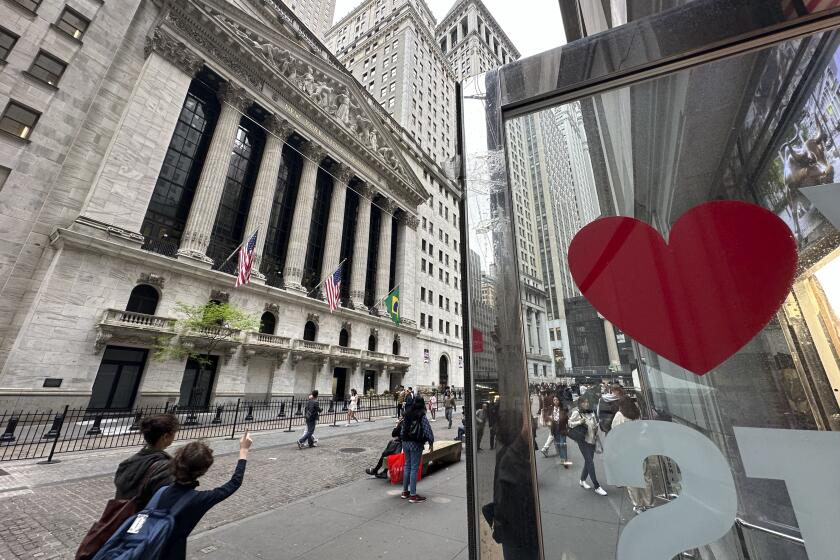Bulls see a lucky Dow 13,000
Are U.S. blue-chip stocks ready to shed their ugly-duckling status?
A surge in big-name shares Wednesday catapulted the Dow index past the 13,000 mark for the first time and boosted hopes that those issues could lead the market to heady gains this year.
The Dow industrials jumped 135.95 points, or 1.1%, to a record 13,089.89 amid a broad rally stoked by upbeat earnings reports and encouraging economic data.
The Dow, whose 30 member stocks include IBM Corp., Coca-Cola Co. and Exxon Mobil Corp., is up 6% in April, on track for its biggest monthly advance since December 2003. Since Jan. 1, it’s up 5%.
A broader blue-chip index, the Standard & Poor’s 500, rose 1% to a 6 1/2 -year high of 1,495.42 and is up 5.2% this month, also the best performance since the final month of 2003.
The strength in blue chips is encouraging to market bulls such as Jason Trennert, investment strategist at Strategas Research Partners in New York, who has been telling clients that the U.S. market could be headed for a “melt-up”: a steep rise in prices fueled by a rush of buying.
Trennert and other optimists say big American stocks -- the bedrock of most investors’ portfolios -- are overdue for a strong rally after lagging far behind most foreign markets in recent years.
The S&P; 500 has risen 28.7% over the last two years. That pales compared with a gain of nearly 138% in Mexico’s market, a 73% rise in German shares and a 54% jump in Australian shares.
The performance disparity between the U.S. and foreign markets suggests that “the U.S. just can’t seem to get any respect,” said Ed Keon, investment strategist at Prudential Equity Group in New York.
But like Trennert, Keon believes that may be changing and that a sharp advance on Wall Street is more likely this year than a downturn.
Also in the bullish camp is Bob Doll, investment chief for stocks at money manager BlackRock Inc. Although he expects a volatile market, “the path of least resistance for stocks continues to be up,” Doll said.
Shares of U.S. blue-chip firms should lead the way, he says, because they offer what he believes many investors are hunting for: high-quality businesses, a way to tap into global economic growth and reasonable share prices relative to underlying earnings.
“All of those things point to U.S. multinationals,” Doll said.
It took the Dow 126 trading days to move from 12,000 to 13,000. By contrast, the advance from 11,000 to 12,000 took more than seven years. The Dow had to recoup its losses in the 2000-to-2002 bear market.
This isn’t the first time in recent years that hopes have been high for the market’s best-known stocks. Many on Wall Street began touting the shares in 2005, to little effect. Foreign markets and U.S. small-company issues continued to attract more investor interest than big-name stocks.
But the stars have aligned for blue chips in recent months, some analysts say. For one, takeover offers for utility titan TXU, student loan company SLM, Bank of New York and others have indicated that corporate buyers see value in large stocks.
What’s more, many big companies remain active buyers of their own shares via stock repurchase programs. IBM said Tuesday that it would borrow to help fund a $15-billion stock buyback -- a clear sign it believes its shares are undervalued.
Blue chips also are gaining as many investors focus again on the prospect of a “soft landing” for the U.S. economy: a slowdown that keeps the Federal Reserve on hold with interest rates but isn’t slow enough to cause earnings to plunge.
That view was reinforced Wednesday as the Fed issued its latest report on regional economic conditions. Despite the nation’s housing slump, the Fed described a “modest or moderate” economic expansion.
Even as the U.S. economy slows, many foreign economies are booming. That has underpinned first-quarter earnings of multinational firms, many of which reported better-than-expected results. A weak dollar is enhancing companies’ results from their overseas operations.
Soft-drink and snack-food maker PepsiCo said Wednesday that its foreign division “performed well on virtually every dimension” in the first quarter.
“This has become a global story where the U.S. has moved away from being the locomotive of the global economy to being more of a car or even the caboose this time around,” said Michael Church of Church Capital Management in Yardley, Pa.
But some market pros warn that it’s usually when Wall Street figures everything is going right that stocks are most vulnerable to a sell-off.
Philip Roth, a veteran analyst at Miller Tabak & Co. in New York, said talk of a “melt-up” made him nervous. “The fact that people are talking that way tells you that things can’t get any better,” he said. Still, he saw few signs that the latest rally was ready to peter out.
Among Wednesday’s market highlights:
* Blue-chip issues leading the Dow higher included IBM, up $2.97 to $101.46; American Express, up $1.41 to $62.32; Boeing, up $1.02 to $94.69; and Alcoa, which rose $1.81 to $35.76 after saying it may sell its packaging and electrical-parts units.
* Amazon.com soared $12.06 to $56.81 after the online retail giant raised its 2007 sales and earnings forecasts Tuesday.
* Joining the Dow industrial average at a record high were the Dow transports index, the Dow utilities index and the New York Stock Exchange composite.
Rising stocks topped losers by more than 2 to 1 on the NYSE.
* The Nasdaq composite rose 23.35 points, or 0.9%, to 2,547.89, a six-year high.
* Near-term crude oil futures rose $1.26 to $65.84 a barrel.
* The yield on the 10-year Treasury note rose to 4.65% from 4.62% on Tuesday.
walter.hamilton@latimes.com
*
(BEGIN TEXT OF INFOBOX)
Lagging the world
U.S. blue-chip stocks have trailed far behind recent gains in many other markets. Price changes in the two years ended Wednesday:
Country/index
*--* Mexico/IPC 137.9% India/Sensex 122.9 Brazil/Bovespa 96.9 Germany/DAX 72.9 S. Korea/compos. 63.4 Sweden/OMX-30 60.9 Japan/Nikkei-225 55.6 Australia/S&P-ASX; 53.6 France/CAC 48.9 Britain/FTSE 100 32.8 U.S./S&P; 500 28.7
*--*
Changes are measured in local currencies.
Source: Bloomberg News
*
(BEGIN TEXT OF INFOBOX)
The Dow’s milestones
The Dow Jones industrial average crossed millennium milestones in fairly rapid succession in the late 1990s, until it peaked at 11,722.98 in January 2000. Losing ground in the 2000-2002 bear market, the Dow took more than seven years to top the 12,000 mark.
*--* Date first Number of trading days Milestone closed above from previous milestone 5,000 Nov. 21, 1995 188 6,000 Oct. 14, 1996 225 7,000 Feb. 13, 1997 84 8,000 July 16, 1997 104 9,000 April 6, 1998 181 10,000 March 29, 1999 245 11,000 May 3, 1999 23 12,000 Oct. 19, 2006 1,878 13,000 April 25, 2007 126
*--*
Source: Dow Jones & Co.






